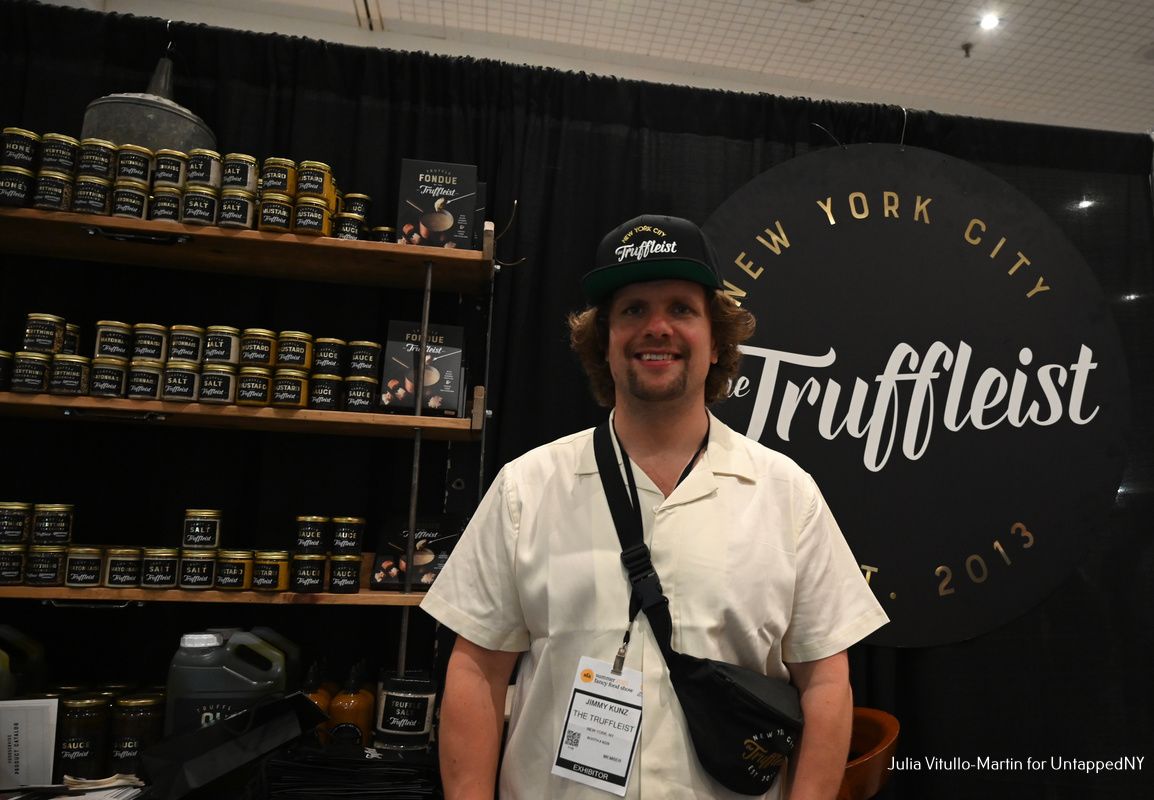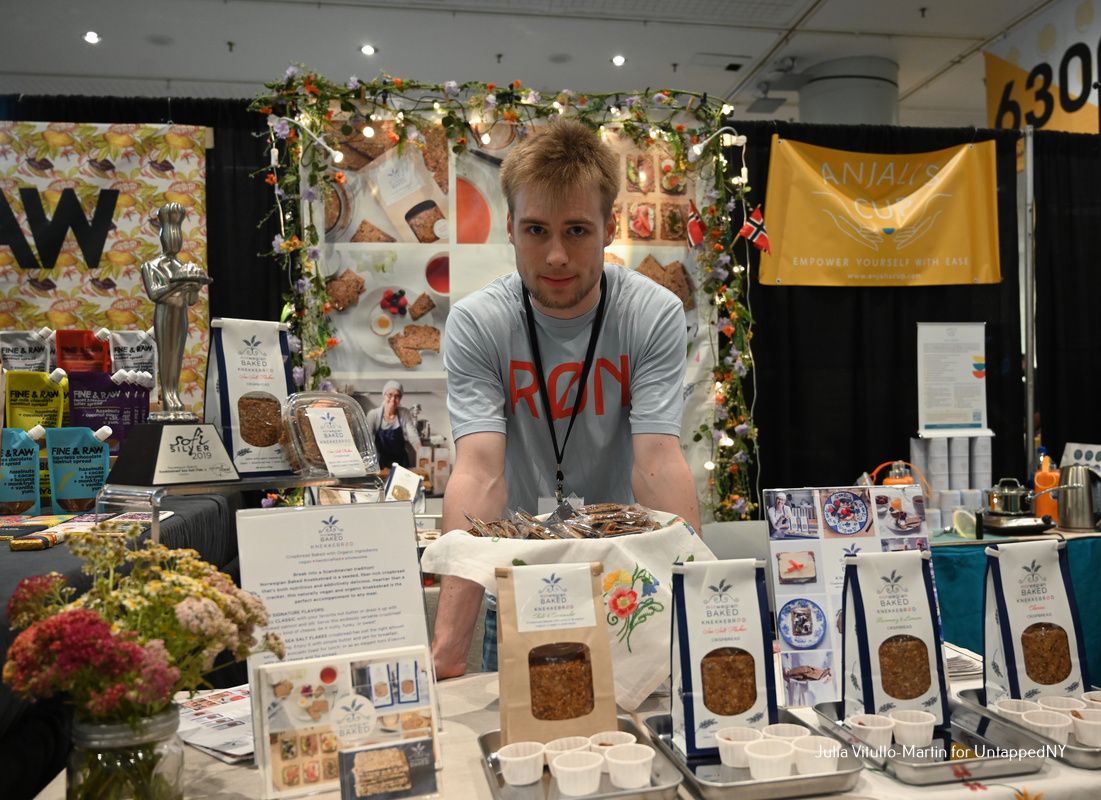Last-Minute NYC Holiday Gift Guide 🎁
We’ve created a holiday gift guide with presents for the intrepid New Yorker that should arrive just in time—



Every summer, NYC food companies flock to the Javits Convention Center’s Fancy Food Show, the largest food industry event in North America. The event showcases superb specialty foods from all over the world—Italy, France, Morocco, India—and New York State. It offers invaluable exposure to companies of all sizes, but especially start-ups and small companies without the resources to promote themselves independently. Discover 5 of those innovative NYC food companies here!

In a hip summary of their business, Cantina Royal’s website announces: “This is the story of Bold, Delicious, and Inventive hot sauces created by a former actress turned flavor connoisseur (Diana Beshara), fueled by the belief in a Dr. Frankenstein-like chef from Mexico (Julio MM) obsessed with the potential of peppers.” Cantina Royal is “proudly woman-owned and minority-owned.”
Chef Julio learned cooking primarily from his mother but he learned food from his unusual upbringing. After the 1985 earthquake destroyed their home in Mexico City’s historic Colonia Roma neighborhood, his family moved into a hotel. They ate out in Mexico City’s full range of restaurants—everything from the corner taco truck to high French. His special love today is Mexican food itself, and Mexican ingredients, which he sources carefully for his five “powerfully flavored, lovingly made-in-Brooklyn” sauces. The sauces “leverage” eight types of fresh and dried chilis from Mexico. No artificial preservatives, chemicals, or colors are used.
To make sure the chiles are precisely right, Chef Julio regularly goes to Mexico, looking for the right terroir that will yield the chiles he wants. A favorite region is Oaxaca, where—as in France—terroirs can shift quickly.
The company started out running what Beshara calls a “cool, vibey restaurant” in Williamsburg, where Chef Julio made all the sauces, which were so popular people stole them off the tables. “That’s when we decided we had to bottle and sell our sauces,” says Beshara.
Cantina Royal’s Tamaulipeka sauce won Saveur Magazine’s designation of Best Overall Hot Sauce, taking “the tongue on a journey, beginning with a gentle sweetness, tempered by the sour of tamarind, then a growing heat on the finish. Though labeled as ‘medium,’ the spice lingers strong.” The sauce is named for the Mexican state of Tamaulipas, where Chef Julio’s mother grew up.
Saveur gave an honorable mention to Cantina Royal’s Tomasa, for its originality and flavor. Like Tamaulipeka, Tomasa uses a corn-oil base but adds garlic, onion, celery, and chia powder plus manzano and habanero peppers for what Saveur calls “a beguilingly savory sauce that brings big intensity without overwhelming everything.”
These days Cantina Royal is “working out of commercial space in Long Island City,” says Beshara. “But we were born in Brooklyn and that’s where we’re hoping to return.”
You can find Cantina Royal sauces at stores across the country, online at Big Apple Box or Heatonist, and many restaurants, including Papatzul in Soho.

Made with fresh, all-natural ingredients that are carefully balanced by renowned mixologist Karl Franz Williams, Uncle Waithley’s Vincy Brew is a small-batch, non-alcoholic carbonated ginger beer that is a marvel of complex flavors and spices. Ginger is a magnificent root that not only makes food and drinks taste better, but it has some 400 natural compounds, many of which are anti-inflammatory and anti-oxidative. Long treasured in the Caribbean and on the island of St. Vincent, where the Williams family is from, ginger is crucial to many products, but especially to non-alcoholic beer. Williams ferments a Peruvian organic ginger that he mixes with turmeric, fresh-squeezed lime juice, and natural salts.
Uncle Waithley, himself a ginger farmer, lived to be 100 years old in part, says Williams, his grandson, because he ate and drank carefully. “Uncle Waithley was my inspiration. He was passionate about health and kind to everyone. He taught me to be aware of details, including ingredients.” From this came the brilliant idea to infuse his Vincy Brew with Scotch Bonnet, a variety of chili pepper that is native to West Africa and ubiquitous in the Caribbean. It has a heat rating similar to habanero’s and gives an unparalleled kick to the beer, which is invaluable to today’s mocktails as well as traditional cocktails.
Williams launched Uncle Waithley’s at Whole Foods Market in Harlem in January 2023, and has since expanded to most New York City locations. It’s also on Amazon and Boisson, and served at some 40 bars, including 67 Orange Street, owned by Williams
At 2082 Frederick Douglass Boulevard in Harlem, 67 Orange Street is worth a trip. The New York Times called it “a tiny, hipsterish joint with very serious bartenders creating $13 cocktails with names like Cleopatra’s Lust and Manhattan After Dark.” Prices have gone up since then, but it’s as hip as ever.

Years ago a representative from Glorious Food, New York’s preeminent caterer, told me that Pigs in a Blanket were by far their most popular offering, even at the poshest Manhattan gatherings at the Met or Lincoln Center. Over and over again I’ve seen that statement borne out at fancy events. You better grab your pigs in a blanket the moment they emerge from the kitchen because they disappear fast. Kathleen Squires of Eater has an apt description: “To New Yorkers, they are tiny hot dogs encased in puff pastry, a snack that falls somewhere between the French saucisson en croute and the Chinese lop cheung bao.”
Missy Koo and Stacey Cole, founders of Brooklyn Piggies, are not exaggerating when they say: “We put the perfect pig in a blanket.”
They started out in 2012, renting a kitchen at The Entrepreneur’s Space in Long Island City and selling their hand-rolled piggies at Brooklyn’s Smorgasburg, the phenomenally successful open-air food market that was anointed by the New York Times as “The Woodstock of Eating.” They had to actually audition, says Koo, to sell at the Smorgasburg. But when Oprah named the Piggies one of her Favorite Things, the founders knew they had to expand beyond their local base. Now they ship nationwide as well as on Fresh Direct and Goldbelly.
Made without artificial seasoning, additives, MSG, or fillers, and sourced entirely in New York State, the Piggies come in four flavors—original, spicy, chicken, and Swiss cheese. And as Koo points out, “These piggies know how to party.”

Few products are as high-end as truffles. Called “the diamond of the kitchen” by French gastronome Jean Anthelme Brillat-Savarin, truffles have been admired—and eaten—by ancient food-lovers from the Sumerians forward. A truffle, says the North American Truffle Growers’ Association, is not a mushroom. It is the spore-bearing fruit of a fungus, and is developed entirely underground.
Truffleist founder Jimmy Kunz is from a foodist-oriented family—dad Gray Kunz was a famous chef, and mom Nicole took Jimmy shopping at food meccas like Schaller & Weber. So it was natural for him to begin his food career by experimenting with truffles. He started with truffle butter, now called “Flagship Truffle Butter” and sold out on the Truffleist website. Made with a ratio of one pound of Black Winter Truffles from Périgord, France, to five pounds of fresh Kriemhild Meadow Butter from grass-fed cows in upstate Hamilton, the butter has a 17% truffle concentration, the highest on the market. He sold his butter at The Smorgasburg (a veritable “summer rock festival for food,” says the New York Times) and also propelled his Vespa all over New York to deliver his butter door-to-door to waiting customers.
He imports his truffles from the countryside of Italy, France, and Spain, and sources his base ingredients locally. His secret of success is what he calls his “collabs,” partnerships with excellent like-minded chefs, producers, and small farms. When walking the Fancy Food Show in 2014, for example, he encountered the family-owned Hudson Valley Cold-Pressed Oil booth. He tasted their “sunflower oil and was blown away by its rich body and depth of flavor.” The result is the superb Truffleist x Hudson Valley Cold Pressed Oil, which is offered in a fun-sized two-ounce bottle. Similarly, in a chat about food trends Chef Casey Corn proposed pairing truffles with “everything” seasoning, now one of Truffleist’s most successful products.
Truffles are no longer niche, says Kunz. As the web site notes, “New products, concepts, and fun flavor combinations busted open the truffle category and condiment business,” encouraging daring experiments. An example is the Truffle Hot Sauce, an amazing combination of carrots, vinegar, lime, peppers, and truffles, made with Smorgasburg pal, Dan Friebar, who created Tango Chile Sauce.
These days Truffleist continues to do the food shows—”We do really great in the Taste NY stores”—and the holiday markets as well as being featured at Whole Foods and smaller ethnic stores.

Getting ready for her wedding—and her two-piece, crop-top dress—Bon Appétit columnist Molly Baz sought out healthy foods. She found Norwegian Baked Knekkebrød, a nutritious mix of rye flour and seeds (pumpkin, sesame, sunflower, and flax) with no white flour, and lots of fiber and good fats. “Salty, earthy, nutty, and crisp as hell,” she wrote, “it’s not for nothin’ that the Norwegians call ‘em crisp breads. They were so good, they edged their way into my regular rotation of snicky-snacks, and have stayed there ever since.”
“Baked with love in Brooklyn” by a family-owned and -run company, Norwegian Baked Knekkebrød is delicious, healthy, and goes well with cheeses, hummus, labneh, soups, patés, basically everything. All crispbreads are nut-free without compromising their savory taste, says founder Hedvig Bourbon. Every order is accompanied with a short, clear ingredient list.
Baked by hand in a commercial kitchen with four ovens at Sunset Park’s Brooklyn Army Terminal, the crispbreads are based on a family recipe shared by her aunt in Norway, but modified by Hedvig. She decided to use extra virgin olive oil, hardly a traditional Norwegian oil, and add more seeds, a blend of pumpkin, flax, sesame, and sunflower. As she told Eleven Madison Home, she hit Park Slope’s 5th Avenue, traveling door-to-door to the neighborhood’s many specialty grocery stores. She received several calls back asking for cases of her crispbread, and from there, “it just snowballed.”
Now she sells in stores all over New York City, including Zabar’s and Eli’s, as well as at her Etsy store, which offers many options plus the ability to comment and communicate with Hedvig.
Next, check out 10 Creatively Themed Cafes in Queens
Subscribe to our newsletter